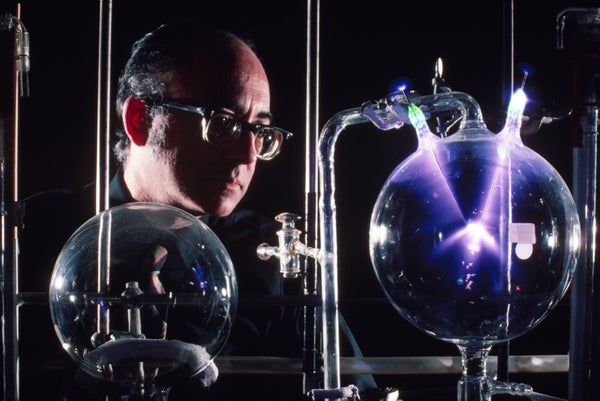Sarah Vitak: This is Scientific American’s 60 Second Science. I’m Sarah Vitak.
The question of how life came to be has captivated humans for millennia. The prevailing theory now is that, on a highly volatile early Earth, lightning struck mineral-rich waters and that the energy from lighting strikes turned those minerals into the building blocks of life: organic compounds like amino acids—something we often refer to as the “primordial soup.”
The wide acceptance of this theory is in large part due to the very famous Miller-Urey experiment. You surely encountered this in a science textbook at some point. But to refresh your memory: in 1952 Stanley Miller and Harold Urey simulated the conditions of early Earth by sealing water, methane, ammonia and hydrogen in a glass flask. Then they applied electrical sparks to the mixture. Miraculously, amino acids came into existence amid the roiling mixture. It was a big deal.
But recently a team of researchers realized that—much like that first primordial soup sitting in a bowl of Earth—the experiment’s container played an underappreciated role—that perhaps it was also critical to the creation of organic building blocks inside their laboratory life soup.
On supporting science journalism
If you're enjoying this article, consider supporting our award-winning journalism by subscribing. By purchasing a subscription you are helping to ensure the future of impactful stories about the discoveries and ideas shaping our world today.
I talked to someone from the team.
Saladino: I am Raffaele Saladino from University of Tuscia in Italy.
Vitak: Then, much like today, when a researcher goes to start an experiment, often one of the first things they do is reach for their glassware. Well, today, actually, we use a lot of plastic as well.
Saladino: But 20 years ago in the lab, only glass containers because, in the mind of the researcher, glass is inert.
Vitak: He said inert, meaning that it doesn’t react with the chemicals you put inside it. But in reality, that is not necessarily always the case.
Most of the time glass is pretty inert. When you’re baking with Pyrex (which is made of borosilicate glass, the same type of glass most labware is made out of) the cookware isn’t going into your brownies. But when you’re baking, whatever is in the pan is usually mostly water, so it will come at a pH of around 7 or so.
But the pH of the Miller-Urey experiment is much higher. In the original experiments, they used a pH of 8.7, which is more alkaline, or basic.
Saladino: Why alkaline environment is an important topic? Since under alkaline condition borosilicate can be impacted through blinds in the reaction menu, it is not inert it became a reagent.
Vitak: In fact, this was actually noted by Miller in his original experiments--that the alkaline conditions caused the silica to dissolve. But it was overshadowed by the discovery of the synthesis of organic compounds. And as future researchers carried on they missed that point in Miller’s notes.
Saladino: The attention was concentrated on modifying the atmosphere, on modifying the energy, the intensity, and modifying the analytical tools.
Vitak: And the role of the silica got forgotten entirely.
Dr. Saladino’s team wanted to see if the glass was doing anything in the reaction. To test this they set up three different versions of the original experiment where everything was the same except the containers. For comparison they chose teflon which does not dissolve when holding an alkaline solution, the way the glass does.
Saladino: There is the experiment only glass, the experiment only Teflon, and in the middle, there is the experiment in teflon with some pieces of glass added inside.
Vitak: Then they used a technique called mass spectrometry to analyze what each reaction produced. Mass spectrometry is great for figuring out what kinds of molecules are in a complex mixture.
They found that teflon produced very few organic compounds. There were more compounds in the teflon with glass pieces. But the glass container, by far, created the greatest number and largest variety of organic molecules.
The mechanism of exactly how the silica helps catalyze the reaction is not clear yet--but it is very clearly does.
The obvious question then is: Was there silica available in the early earth environment?
Saladino: The water is not suspended in a vacuum. No? The water is in geochemistry, it is surrounded by minerals. Borosilicate and silica are the most abundant minerals surrounding the water.
Vitak: The team has two next major objectives in mind. First, to try updating the experiment to model more closely the amount of silica that would have been available in the early Earth.
Second, they want to try replacing the silica with extraterrestrial minerals like, pieces of meteorite or rocks from other planets. Apart from just being very cool, that could give a more concrete idea of how to look for life in space.
But here on Earth, coming one step closer to fully understanding why we exist is that much more satisfying. Even after nearly 70 years, a key discovery in our complex origin story still carries new revelations. As the authors say in the paper: "The role of the rocks was hidden in the walls of the reactors."
Thanks for listening. For Scientific American’s 60 Second Science, I’m Sarah Vitak.
[The above text is a transcript of this podcast.]

